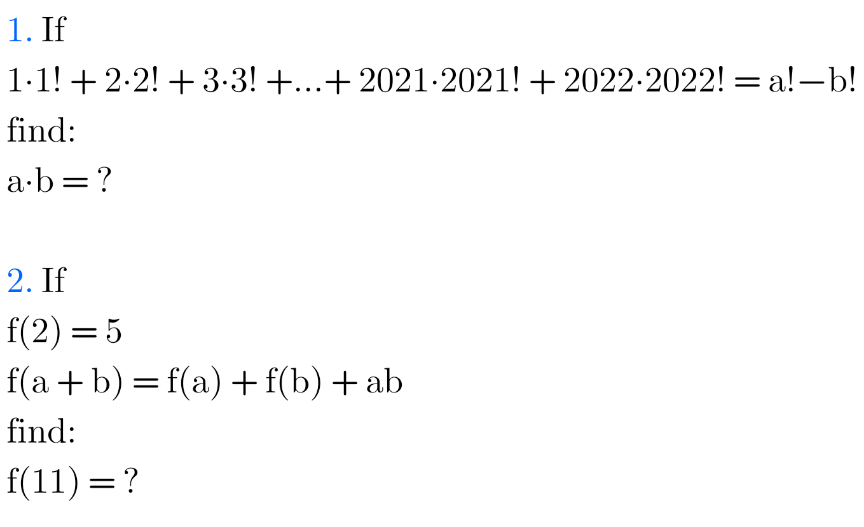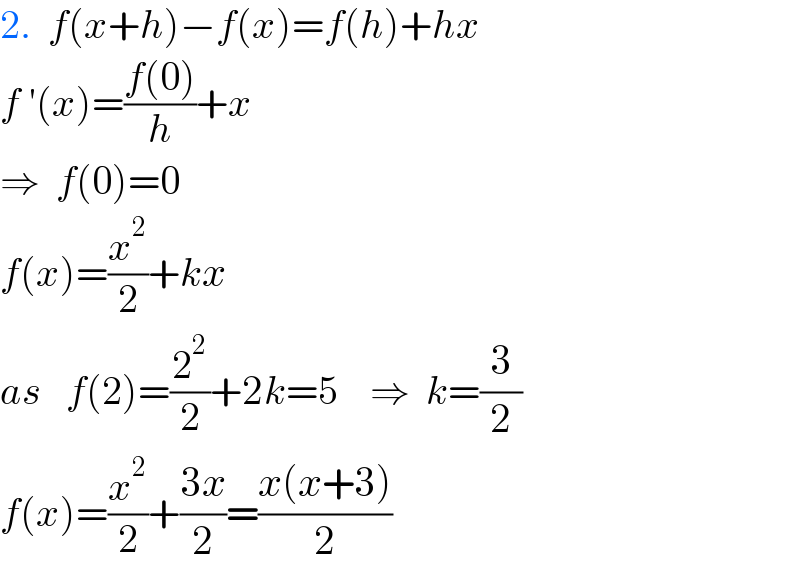
Question Number 199547 by hardmath last updated on 05/Nov/23

Answered by mr W last updated on 05/Nov/23

$$\left.\mathrm{1}\right) \\ $$$${n}×{n}!=\left({n}+\mathrm{1}−\mathrm{1}\right)×{n}!=\left({n}+\mathrm{1}\right)!−{n}! \\ $$$$\mathrm{1}×\mathrm{1}!+\mathrm{2}×\mathrm{2}!+...+\mathrm{2022}×\mathrm{2022}! \\ $$$$=\mathrm{2}!−\mathrm{1}!+\mathrm{3}!−\mathrm{2}!+....+\mathrm{2023}!−\mathrm{2022}! \\ $$$$=\mathrm{2023}!−\mathrm{1}! \\ $$$$\Rightarrow{ab}=\mathrm{2023}×\mathrm{1}=\mathrm{2023} \\ $$$$ \\ $$$$\left.\mathrm{2}\right) \\ $$$${f}\left({a}+{b}\right)={f}\left({a}\right)+{f}\left({b}\right)+{ab} \\ $$$${f}\left(\mathrm{2}{a}\right)=\mathrm{2}{f}\left({a}\right)+{a}^{\mathrm{2}} \\ $$$$ \\ $$$${f}\left(\mathrm{2}\right)=\mathrm{2}{f}\left(\mathrm{1}\right)+\mathrm{1}^{\mathrm{2}} =\mathrm{5}\:\Rightarrow{f}\left(\mathrm{1}\right)=\mathrm{2} \\ $$$${f}\left(\mathrm{4}\right)=\mathrm{2}{f}\left(\mathrm{2}\right)+\mathrm{2}^{\mathrm{2}} =\mathrm{2}×\mathrm{5}+\mathrm{4}=\mathrm{14} \\ $$$${f}\left(\mathrm{5}\right)={f}\left(\mathrm{4}\right)+{f}\left(\mathrm{1}\right)+\mathrm{4}×\mathrm{1}=\mathrm{14}+\mathrm{2}+\mathrm{4}=\mathrm{20} \\ $$$${f}\left(\mathrm{10}\right)=\mathrm{2}{f}\left(\mathrm{5}\right)+\mathrm{5}^{\mathrm{2}} =\mathrm{2}×\mathrm{20}+\mathrm{25}=\mathrm{65} \\ $$$${f}\left(\mathrm{11}\right)={f}\left(\mathrm{10}\right)+{f}\left(\mathrm{1}\right)+\mathrm{10}×\mathrm{1}=\mathrm{65}+\mathrm{2}+\mathrm{10}=\mathrm{77} \\ $$$$ \\ $$$${or}\:{generally}\:{f}\left({x}\right)=\frac{{x}\left({x}+\mathrm{3}\right)}{\mathrm{2}} \\ $$$$\Rightarrow{f}\left(\mathrm{11}\right)=\frac{\mathrm{11}×\mathrm{14}}{\mathrm{2}}=\mathrm{77} \\ $$
Commented by hardmath last updated on 05/Nov/23

$$\mathrm{thank}\:\mathrm{you}\:\mathrm{dear}\:\mathrm{professor}\:\mathrm{cool} \\ $$
Commented by hardmath last updated on 05/Nov/23

$${thank}\:{you}\:{dear}\:{professor}\:{perfect}\:{solutions} \\ $$
Commented by hardmath last updated on 05/Nov/23

$$\mathrm{dear}\:\mathrm{professor}, \\ $$$$\mathrm{how}\:\mathrm{did}\:\mathrm{you}\:\mathrm{get}\:\mathrm{the}\:\mathrm{generalized}\:\mathrm{solution} \\ $$$$\mathrm{and}\:\mathrm{is}\:\mathrm{it}\:\mathrm{always}\:\mathrm{true}? \\ $$
Commented by mr W last updated on 05/Nov/23

$${since}\:{f}\left({x}+{y}\right)={f}\left({x}\right)+{f}\left({y}\right)+{xy},\:{you}\:{can} \\ $$$${assume}\:{f}\left({x}\right)={ax}^{\mathrm{2}} +{bx}+{c}\:{with}\:{f}\left(\mathrm{2}\right)=\mathrm{5}. \\ $$$${then}\:{you}\:{get}\:{a}=\frac{\mathrm{1}}{\mathrm{2}},\:{b}=\frac{\mathrm{3}}{\mathrm{2}},\:{c}=\mathrm{0}. \\ $$
Answered by deleteduser1 last updated on 05/Nov/23

$${f}\left(\mathrm{4}\right)=\mathrm{10}+\mathrm{4}=\mathrm{14}\Rightarrow{f}\left(\mathrm{8}\right)=\mathrm{44} \\ $$$$\mathrm{5}=\mathrm{2}{f}\left(\mathrm{1}\right)+\mathrm{1}\Rightarrow{f}\left(\mathrm{1}\right)=\mathrm{2};{f}\left(\mathrm{3}\right)=\mathrm{7}+\mathrm{2}=\mathrm{9} \\ $$$${f}\left(\mathrm{11}\right)=\mathrm{44}+\mathrm{9}+\mathrm{24}=\mathrm{77} \\ $$
Commented by hardmath last updated on 05/Nov/23

$${thank}\:{you}\:{professor} \\ $$
Answered by ajfour last updated on 05/Nov/23

$$\mathrm{2}.\:\:{f}\left({x}+{h}\right)−{f}\left({x}\right)={f}\left({h}\right)+{hx} \\ $$$${f}\:'\left({x}\right)=\frac{{f}\left(\mathrm{0}\right)}{{h}}+{x} \\ $$$$\Rightarrow\:\:{f}\left(\mathrm{0}\right)=\mathrm{0} \\ $$$${f}\left({x}\right)=\frac{{x}^{\mathrm{2}} }{\mathrm{2}}+{kx} \\ $$$${as}\:\:\:{f}\left(\mathrm{2}\right)=\frac{\mathrm{2}^{\mathrm{2}} }{\mathrm{2}}+\mathrm{2}{k}=\mathrm{5}\:\:\:\:\Rightarrow\:\:{k}=\frac{\mathrm{3}}{\mathrm{2}} \\ $$$${f}\left({x}\right)=\frac{{x}^{\mathrm{2}} }{\mathrm{2}}+\frac{\mathrm{3}{x}}{\mathrm{2}}=\frac{{x}\left({x}+\mathrm{3}\right)}{\mathrm{2}} \\ $$
Commented by hardmath last updated on 05/Nov/23

$${thank}\:{you}\:{professor} \\ $$
